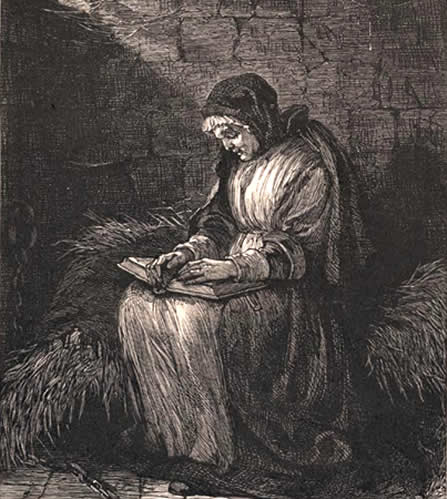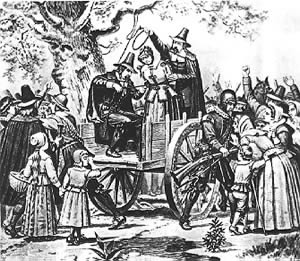The desire to understand why people hunt witches runs much deeper. Schiff reminds us that it was the Holocaust that sent historian Marion Starkey into the Salem archives. Aided by court records previously scattered throughout the North Shore of Massachusetts and assembled during the Works Progress Administration into three giant volumes, she published The Devil in Massachusetts: A Modern Enquiry Into the Salem Witch Trials in 1949. It offered up the first psychological portrait of the event and its characters, in particular the development of childish fantasies into teenage hysteria. It was this volume that Miller picked up to begin his research, the perfect entrance for a storyteller.
 |
Craig White's Literature Courses Critical Sources Salem’s Reign of TerrorStacy Schiff unravels the twisted history of the Salem Witch Trials. |
 Susan Martin in Prison |
When The Crucible debuted on Broadway in 1953, Arthur Miller famously declared, “Salem is one of the few dramas in history with a beginning, a middle, and an end.” It’s a catchy sound bite—but what is this “end” he talks about? The collective nightmare certainly began in January 1692, when nine-year-old Betty Parris and eleven-year-old Abigail Williams erupted in unstoppable spasms, barks, and twitches; the middle of the drama reached a climax with the bodies that swung on Gallows Hill over that summer; and the final act arrived with the last trials in the spring of 1693, when the Massachusetts Bay Colony snapped awake at last, delivering not-guilty verdicts to those still on trial and pardoning the rest. By then, 19 innocent women and men had been hung and one man had been pressed to death by heavy stones.
But the trauma wrought by America’s very own “tiny reign of terror,” as Stacy Schiff describes the Salem witch trials in her new book The Witches: Salem, 1692, has no end in sight. For more than 300 years, public appetite for the topic has been insatiable—it’s as if we as a nation are doomed to tell and retell this story to each new traveler who passes by.
Each time we relive the anguish of Salem, do we expect to learn something new about ourselves? “We tend to revisit our national crack-up after miscarriages of justice,” Schiff writes. But the “witch hunt,” as the political metaphor we know today, is largely a twentieth-century phenomenon. An entire chapter of the 1885 adventure novel King Solomon’s Mines is titled “The Witch-Hunt,” but there is a literalism to the term: “To-night ye will see. It is the great witch-hunt, and many will be smelt out as wizards and slain.” Several decades later, there is evidence of the phrase entering the vernacular at a 1919 congressional subcommittee hearing convened under the title “Bolshevik Propaganda.” In his testimony, Raymond Robins, who had led a Red Cross mission to Russia in 1917, said about Bolshevism, “I have faith enough in our institutions to believe that we will throw that foreign culture, born out of a foreign despotism, back out of our land, not by treating it with the method of tyranny, not by a witch hunt, nor by hysteria, but by strong, intelligent action.” He goes on, but his inquisitor cuts him off: “What do you mean by ‘witch hunt’?” he asked. “That when people get frightened at things and see bogies, then they get out witch proclamations, and mob action and all kinds of hysteria takes place,” Robins explained.
In 1952, around the time Miller’s friend, director Elia Kazan, outed eight of their creative colleagues as Communists to the House Un-American Activities Committee, the disgruntled playwright traveled to the Salem library. Playing loose with Starkey’s book and the few recorded documents—altering ages, creating character composites, adding a romantic backstory—he emerged with a masterful four-act allegory for the “witch hunt.” Miller had an important goal for his play, which he wrote down in his notebook: “It must be tragic.” But instead, he was swept away by the bureaucracy of evil. The New York Times drama critic Brooks Atkinson, in his opening night review of The Crucible, wrote that Miller “has permitted himself to be concerned more with the technique of the witch hunt than with its humanity,” and declared it, as a drama, still in the shadow of Death of a Salesman. Note that it’s The Crucible, however, that remains Miller’s most frequently produced work. (The next Broadway revival is scheduled for spring 2016.)
As for Miller’s famous quote, it was Starkey who said it first, in her preface to The Devil in Massachusetts: “I have tried to uncover the classic dramatic form of the story itself, for here is a real ‘Greek tragedy,’ with a beginning, a middle, and an end.” (Unlike Miller, however, she tried her best in the book to let the characters speak for themselves and not “blur their portraits with the sentimentality and flares of moral indignation.”) The narrative of Salem itself is a story “pockmarked by seventeenth-century deletions and studded with nineteenth-century inventions,” Schiff writes. Her history is a corrective to Miller and Starkey, who have carved a narrative out of ambiguous events. Schiff is unsentimental and undramatic, she resists a beginning, middle, and end. According to her, the end of Salem is nowhere in sight.
Why then would a Pulitzer Prize-winning twenty-first century biographer yoke herself anew to the Salem witch trials unless she comes bearing news? In The Witches, Schiff is an industrious schoolmarm; unlike Miller, the news she bears has little to do with tragedy, and even less to do with conclusions. She has produced a nearly 500-page history that feels uncannily like a (slightly overstuffed) biography, in which even the most theatrical plot points are treated as plain, hard facts to be marshaled and accounted for in a rigorous chronology.
This was no small feat, given how few documents there are for a historian to work with: Not a single session of the witchcraft court survives. The only extant source materials are depositions, indictments, confessions, petitions, and two death warrants—crusted over with three centuries’ worth of interpretation and speculation, which began with Cotton Mather’s unabashedly subjective The Wonders of the Invisible World. Penned while witches still flew outside his window and published in 1693, today it has become a guide for the medieval cast of the Puritan mind, which believed as devoutly in devils, witches, and their familiars as it did in God himself. In the eighteenth century, there came a long, guilty silence, during which everybody did their best to never again think or talk about those feeble-minded colonials and their unseemly credulity. Then, in 1831, Charles W. Upham, Harvard classmate of Ralph Waldo Emerson and the seventh mayor of Salem, tore off the muzzle and delivered his “Lectures on Witchcraft,” republished in 1867 as the first definitive history of the trials. This incurable unknowability—“the irresistible locked-room mystery of the matter,” Schiff writes—largely accounts, she argues, for Salem’s enduring appeal. “If we knew more about Salem, we might attend to it less, a conundrum that touches on something of what propelled the witch panic in the first place.”
As she did with her 2010 biography Cleopatra, Schiff honors her subject’s gaping documentary absences by fleshing out the actual world in which the witch panic took root and thrived, showing the full range of factors that influenced its participants—young and old, rich and poor, male and female—with gratifying vividness. Puritan settlers were “ardent, anxious, unbashful, incurably logical” religious fanatics who “breathed, dreamed, disciplined, bartered, and hallucinated in biblical texts and imagery.” (The average churchgoer heard 15,000 hours of sermons in his lifetime.) As such, they were “not quite Americans, as homogeneous a culture as has ever existed on this continent.” Dressed in stiff cottons and scratchy wools in muted earth tones, they lived in “dim, smoky, firelit homes” that were “perched on the uncomfortable edge of an unpredictable wilderness,” howling with “the devilish savage, the swarthy terrorist.” The air was so silent—“the slap of a beaver’s tail against the water could be heard a half a mile off”—that everyday sounds were distorted into auditory illusions. Even their dark wasn’t ours: “The sky over New England was crow black, pitch-black, Bible black.” Resources were dismayingly scarce. During the winter of 1692, the Massachusetts Bay was awaiting a new charter, so it didn’t even have a governor.
From this cauldron of fear and insecurity arose a terrible weakness. Ministers eager to evince their purity by battling with the devil pressured young girls into “naming” witches. Young girls high on their bewildering, newfound influence—most likely an outbreak of what’s now known as conversion disorder, in which mental stress manifests itself as a physical problem—complied by accusing the most obvious suspects, middle-aged female outcasts (the first two, at least). When the hysteria spread, farmers engaged in longstanding boundary disputes willfully transformed their grievances into suspicion of supernatural doings. The innocent tried to protect themselves by confessing guilt. As the circle of accusations widened to include more and more “respectable” people, the magistrates and ministers came to their senses.
Indeed, Schiff is so convincing about the personal motivations driving these powerful men, I was surprised to see her take up the longstanding feminist assertion that by making themselves “heard” the bewitched girls exhibited an unprecedented agency—America’s first feminist uprising. From where I sit, it seems more likely that an internalized misogyny compelled the young women to send their elders to their deaths, and it has absolutely nothing to do with the nineteenth- and twentieth-century suffrage movement, when, as Schiff argues, “a different scourge encouraged [women] to raise their voices.”
If Schiff is right to accuse us of nurturing an unrequited infatuation with what amounts to America’s first tabloid scandal, then she’s done the literary equivalent of force us into a cold shower. The Witches rescues the trials from the free-floating range of hypothesis, hyperbole, and metaphor that have kept so many questions alive for so long. Schiff ably demonstrates that the witch trials, like so many reigns of terror, were a thoroughly un-fantastical, depressing, and mundane affair. What Salem has to teach us is how often we like to look in the mirror, no matter how unappealing the reflection.
